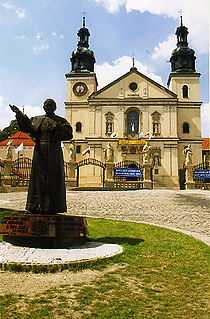Kalwaria Zebrzydowska park
| Kalwaria Zebrzydowska: the Mannerist Architectural and Park Landscape Complex and Pilgrimage Park | |
|---|---|
| Name as inscribed on the World Heritage List | |
 | |
| Type | Cultural |
| Criteria | ii, iv |
| Reference | 905 |
| UNESCO region | Europe and North America |
| Inscription history | |
| Inscription | 1999 (23rd Session) |
Kalwaria Zebrzydowska park is a Mannerist architectural and park landscape complex and pilgrimage park, built in the 17th century as the Counter Reformation in the late 16th century led to prosperity in the creation of Calvaries in Catholic Europe.
The park, located near the town of Kalwaria Zebrzydowska, which took its name from the park, was added in 1999 to the UNESCO list of World Heritage Sites. The site is also one of Poland's official national Historic Monuments (Pomnik historii), as designated November 17, 2000 and tracked by the National Heritage Board of Poland.
History
Kalwaria Zebrzydowska was established in 1600 by Mikołaj Zebrzydowski, voivode of Kraków for Franciscan monks (custodians of the Holy Sepulchre in Jerusalem). It was modelled on the 1584 map of Jerusalem by Christian Kruik van Adrichem.[1]
Structures
- Basilica of St. Mary was established by Mikołaj Zebrzydowski for Order of Friars Minor. The church was designed by Giovanni Maria Bernardoni and the construction process was conducted by Paul Baudarth, an architect and goldsmith from Antwerp, between 1603-1609.[2]
- Ecce Homo Chapel was built on the plan of the Greek cross between 1605-1609 by Paul Baudarth. The vault adorned with profuse stucco decorations in the style of Dutch mannerism.[3]
- Chapel of the Crucifixion is the first structure built by Mikołaj Zebrzydowski in Kalwaria and give a beginning to the whole complex.[4] It was constructed between 1600-1601.
- Heart of Mary Chapel was built on the plan of a heart in 1615 by Paul Baudarth. The chapel commemorate Jesus' encounter with Mary on the road to Calvary.[5]
Images
-

Monastery
-

Interior of the Church
-

Ecce Homo Chapel
-
Courtyard
See also
References
- ↑ "Kalwarie w Europie". www.niedziela.pl (in Polish). Retrieved 2009-12-28.
- ↑ "Sanktuarium Kalwaryjskie". www.pascal.pl (in Polish). Retrieved 2009-12-28.
- ↑ "Ratusz Pilata". www.kalwaria.eu (in Polish). Retrieved 2009-12-28.
- ↑ "Ważniejsze wydarzenia". www.kalwaria.eu (in Polish). Retrieved 2009-12-28.
- ↑ "Kaplica Serca Maryi". www.kalwaria.eu (in Polish). Retrieved 2009-12-28.
External links
| Wikimedia Commons has media related to Kalwaria Zebrzydowska. |
- Kalwaria Zebrzydowska city website
- The Kalwaria Zebrzydowska Sanctuary (English) (Polish)
| ||||||
